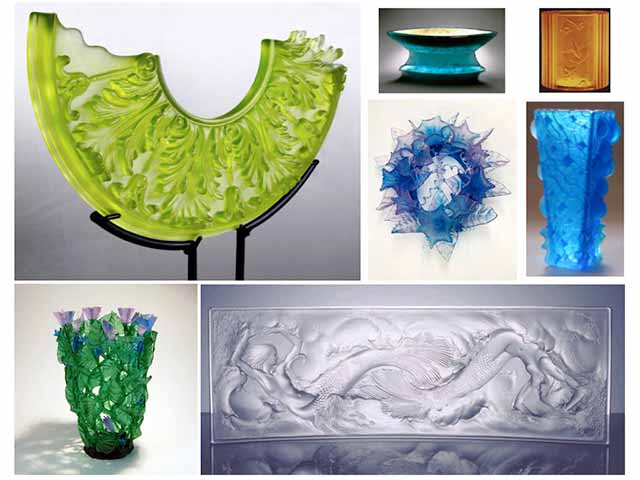Description
R&R GLASS-CAST 910 is R&R's benchmark mold material. Developed over 20 years ago, GLASS-CAST 910 has become a staple in the glass casting community. R&R GLASS-CAST 910 is widely recognized as the strongest mold material available for glass casting on the market today. This is the glass caster's best choice for large pieces or configurations that will place significant stress on the mold material. Packaged in a 50 pound carton.
Properties
TECHNICAL DATA
Mix ratio: 28 parts water to 100 parts powder by weight
Volume of mixed Glass-Cast 910: 16.39ml per cubic inch, 15.98 cu.in./Lb
Weight (mixed) per cubic inch: 28.4 grams (22.2g powder : 6.2g water)
Weight (mixed) per U.S. gallon: 14.46 Lbs (6564.84 grams)
If too much water is used, the mold will be too weak to hold the molten glass. In this case, the glass can break through the mold and leak out onto the kiln. As casting size increases, this becomes even more important since the larger mass of molten glass places more stress on the mold material.
If too little water is used, the working time of the mold material will be too short which will not leave enough time to complete all of the mold making steps. This can result in loss of detail reproduction, trapped air and finning.
The R&R GLASS-CAST mold materials come with a silica warning, what does that mean to me? Crystalline silica is one component of R&R GLASS-CAST mold materials. This portion of the formula is necessary to allow the mold material to reach appropriate firing temperatures. Crystalline silica has also been identified by the International Agency for the Research of Cancer (IARC) as a substance known to cause cancer in humans after prolonged exposure.
The warning provides data on the possible delayed lung injury effects of prolonged exposure to the dust generated from using R&R GLASS-CAST mold materials. Precautions, such as face masks and dust collection systems, should be used to limit the amount of silica breathed while working with these mold materials. The Material Safety Data Sheet (MSDS) provides detailed information.
Will fibers improve the strength of my mold? Will they affect the surface of the glass? Similar to the way rebar improves the strength of concrete, fiber glass can improve the strength of a mold. While the investment is fluid, plaster flows all around the fibers, shielding them from the pattern itself. What results is a plaster barrier between any fibers and the casting. This barrier keeps the surface of the glass from being affected.
Will the temperature of my water affect the mold? Not directly; however, temperature does affect the working time of the mold material and this can affect the mold indirectly. For every 10 deg F increase in temperature of the water & powder, the working time of the mold material decreases by approximately 1 minute. If the mold making steps are not completed within this shortened working time, the result will be a malformed mold.
Conversely, if temperatures are lowered, the working time is increased and there is a possibility that the water can separate from the powder before the mold material sets. This results in water-marking on the casting. R&R GLASS-CAST 910 and R&R GLASS-CAST 400 mold materials have special chemicals to prohibit this separation. R&R GLASS-CAST 101 and other investments do not.
Is a face coat necessary for using R&R GLASS-CAST mold materials? No, each of the R&R GLASS-CAST mold materials can reproduce the finest detail without a face coat. During the mold making process, plaster rich water flows into the tiniest crevasses even though coarser refractory particles cannot. This plaster rich water will transform into gypsum and set hard. In a sense, a face coat is naturally formed during this process.
Rough castings can result if this plaster rich skin is somehow disturbed. A common mistake that leads to rough castings is excessive steam dewaxing, which erodes away this rich gypsum layer. Scrapping the inside of the mold also will remove the gypsum-rich layer, resulting in in rough areas on the casting.
If using a face coat, the mold material may not bond consistently with this layer. This can cause inclusions in the casting and loss of detail in reproduction. Face coats often have different expansion characteristics than the rest of the mold materials as well. This results in cracking and shifting in the mold, leading to fins on the castings.
Documentation
Payment & Security
Your payment information is processed securely. We do not store credit card details nor have access to your credit card information.

